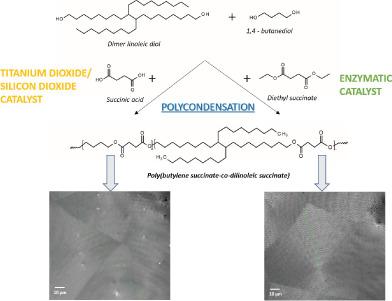当前位置:
X-MOL 学术
›
Polym. Int.
›
论文详情
Our official English website, www.x-mol.net, welcomes your
feedback! (Note: you will need to create a separate account there.)
Effect of enzymatic versus titanium dioxide/silicon dioxide catalyst on crystal structure of ‘green’ poly[(butylene succinate)‐co‐(dilinoleic succinate)] copolymers
Polymer International ( IF 2.9 ) Pub Date : 2020-08-25 , DOI: 10.1002/pi.6104 Martyna Sokołowska 1 , Ewa Stachowska 2 , Michalina Czaplicka 2 , Miroslawa El Fray 1
Polymer International ( IF 2.9 ) Pub Date : 2020-08-25 , DOI: 10.1002/pi.6104 Martyna Sokołowska 1 , Ewa Stachowska 2 , Michalina Czaplicka 2 , Miroslawa El Fray 1
Affiliation

|
Focusing on an eco‐friendly approach, biodegradable poly[(butylene succinate)‐co‐(dilinoleic succinate)] (PBS‐DLS) copolymers with 70:30 (wt%) ratio of hard to soft segments were successfully synthesized via various processes and catalytic systems. In this approach, biobased succinate was polymerized with renewable 1,4‐butanediol and dimer linoleic diol to obtain ‘green’ copolyesters as sustainable alternatives to petroleum‐based materials. In the first procedure, a two‐step synthesis in diphenyl ether was performed using Candida antarctica lipase B (CAL‐B) as a biocatalyst. A second material was produced via two‐step melt polycondensation in the presence of heterogeneous titanium dioxide/silicone dioxide (C‐94) catalyst. The obtained PBS‐DLS copolyesters were further characterized in regard to their number‐average molecular weight (Mn), chemical structure, thermal transition temperatures and crystallization behavior. Here, digital holographic microscopy was used to study the crystallization behavior of synthesized segmented copolyesters for the first time. Using this technique, it was possible to reveal the twisting of crystalline regions in formed spherulites and observe the differences in crystallization behavior of copolyesters depending on the type of catalyst used in their synthesis. Structural characterization indicated random and blocky structure of copolymers depending on the type of catalyst. Mn was noticeably higher in the case of PBS‐DLS 70:30 copolymer catalyzed using C‐94 than PBS‐DLS 70:30 synthesized with the use of CAL‐B. However, the degree of crystallinity was lower for polymer catalyzed with the heterogeneous catalyst. Furthermore, differential scanning calorimetric thermal analysis revealed that synthesized copolyesters exhibit low glass transition temperature as well as high melting point which are typical for thermoplastic elastomers. © 2020 Society of Chemical Industry
中文翻译:

酶对二氧化钛/二氧化硅催化剂对'绿色'聚[(丁二酸丁二酯)-共-(二亚丁二酸丁二酸酯)]共聚物共聚物晶体结构的影响
着眼于一个生态友好的方式,可生物降解的聚[(丁二酸丁二醇酯) -共- (亚油酸琥珀酸酯)](PBS-DLS)用的硬到软链段70:30(重量%)比率的共聚物被成功地通过各种方法合成,并催化系统。通过这种方法,将生物基琥珀酸酯与可再生的1,4-丁二醇和二聚亚油酸二醇聚合,以获得“绿色”共聚酯,作为石油基材料的可持续替代品。在第一个步骤中,使用南极假丝酵母在二苯醚中进行了两步合成脂肪酶B(CAL‐B)作为生物催化剂。在异相二氧化钛/二氧化硅(C-94)催化剂存在下,通过两步熔融缩聚反应生产出第二种材料。获得的PBS‐DLS共聚酯的数均分子量(M n),化学结构,热转变温度和结晶行为。在这里,数字全息显微镜首次用于研究合成的分段共聚酯的结晶行为。使用这种技术,可以揭示形成的球晶中结晶区域的扭曲,并观察共聚酯的结晶行为差异,这取决于它们合成中所用催化剂的类型。结构表征表明,取决于催化剂的类型,共聚物的无规和嵌段结构。中号ñ使用C-94催化的PBS-DLS 70:30共聚物的情况明显高于使用CAL-B合成的PBS-DLS 70:30的情况。但是,用非均相催化剂催化的聚合物的结晶度较低。此外,差示扫描量热分析表明,合成的共聚酯表现出低的玻璃化转变温度以及高的熔点,这对于热塑性弹性体是典型的。©2020化学工业协会
更新日期:2020-08-25
中文翻译:

酶对二氧化钛/二氧化硅催化剂对'绿色'聚[(丁二酸丁二酯)-共-(二亚丁二酸丁二酸酯)]共聚物共聚物晶体结构的影响
着眼于一个生态友好的方式,可生物降解的聚[(丁二酸丁二醇酯) -共- (亚油酸琥珀酸酯)](PBS-DLS)用的硬到软链段70:30(重量%)比率的共聚物被成功地通过各种方法合成,并催化系统。通过这种方法,将生物基琥珀酸酯与可再生的1,4-丁二醇和二聚亚油酸二醇聚合,以获得“绿色”共聚酯,作为石油基材料的可持续替代品。在第一个步骤中,使用南极假丝酵母在二苯醚中进行了两步合成脂肪酶B(CAL‐B)作为生物催化剂。在异相二氧化钛/二氧化硅(C-94)催化剂存在下,通过两步熔融缩聚反应生产出第二种材料。获得的PBS‐DLS共聚酯的数均分子量(M n),化学结构,热转变温度和结晶行为。在这里,数字全息显微镜首次用于研究合成的分段共聚酯的结晶行为。使用这种技术,可以揭示形成的球晶中结晶区域的扭曲,并观察共聚酯的结晶行为差异,这取决于它们合成中所用催化剂的类型。结构表征表明,取决于催化剂的类型,共聚物的无规和嵌段结构。中号ñ使用C-94催化的PBS-DLS 70:30共聚物的情况明显高于使用CAL-B合成的PBS-DLS 70:30的情况。但是,用非均相催化剂催化的聚合物的结晶度较低。此外,差示扫描量热分析表明,合成的共聚酯表现出低的玻璃化转变温度以及高的熔点,这对于热塑性弹性体是典型的。©2020化学工业协会











































 京公网安备 11010802027423号
京公网安备 11010802027423号